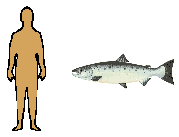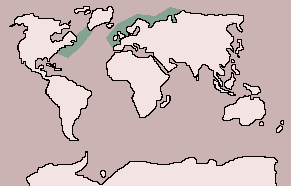Atlantic Salmon

| Class: Fishes: 4
classes |
Diet: Crustaceans |
| Order:
Salmoniformes: Salmon |
| Size:
up to 1.5 m (5 ft) |
| Family: No Fish family
information |
Conservation Status:
Non-threatened |
| Scientific Name: Salmo
salar |
Habitat: open seas;
rivers |
| Range:
Northern Atlantic Ocean: Greenland to Cape Cod; Arctic coast of Russia,
south to Northern Spain |
 The
best known of its family, the Atlantic Salmon is a long-bodied, rounded
fish with a slightly forked tail. There are some salmon in inland lakes,
but most are migratory, moving from their natal river out to sea and then
back to the river to spawn. The salmon enter the river at different
times but all spawn in the winter. Breeding males develop hooked protuberances
on their lower jaws. Having excavated a shallow nest in the gravel of the
riverbed, the female lays her eggs while the male lies next to her fertilizing
them. The eggs overwinter and hatch the following spring. After spending
2 to 6 years in the river, the salmon go out to sea, returning to spawn
from 1 to 4 years later. Unlike Pacific salmon, Atlantic salmon can spawn
more than once in their lifetime. The
best known of its family, the Atlantic Salmon is a long-bodied, rounded
fish with a slightly forked tail. There are some salmon in inland lakes,
but most are migratory, moving from their natal river out to sea and then
back to the river to spawn. The salmon enter the river at different
times but all spawn in the winter. Breeding males develop hooked protuberances
on their lower jaws. Having excavated a shallow nest in the gravel of the
riverbed, the female lays her eggs while the male lies next to her fertilizing
them. The eggs overwinter and hatch the following spring. After spending
2 to 6 years in the river, the salmon go out to sea, returning to spawn
from 1 to 4 years later. Unlike Pacific salmon, Atlantic salmon can spawn
more than once in their lifetime.

  
|
